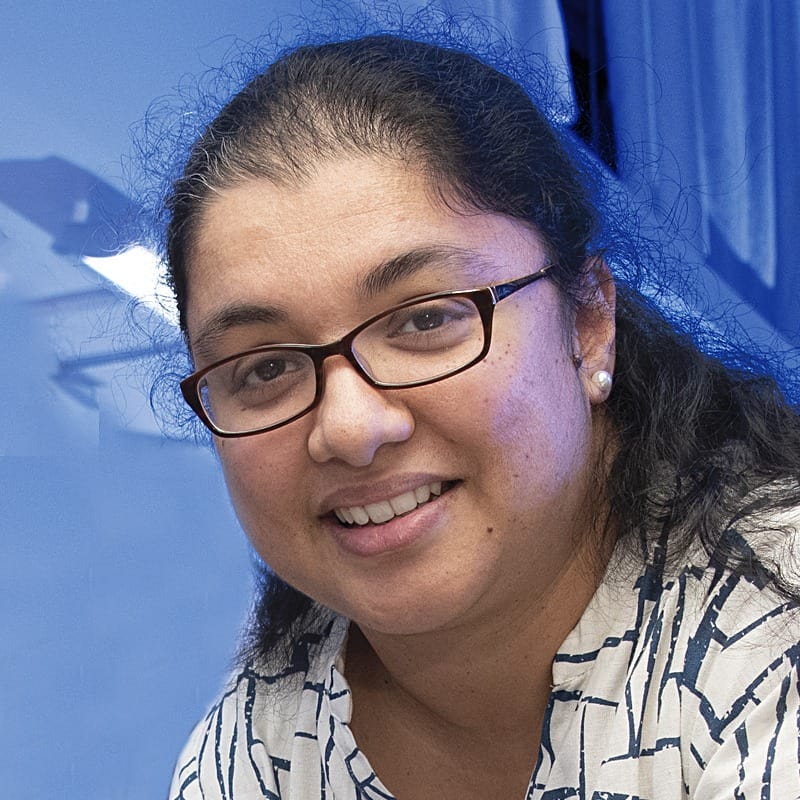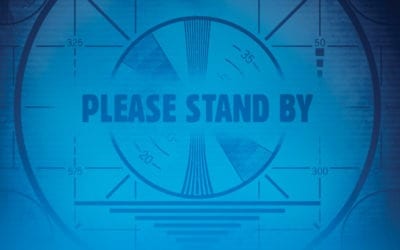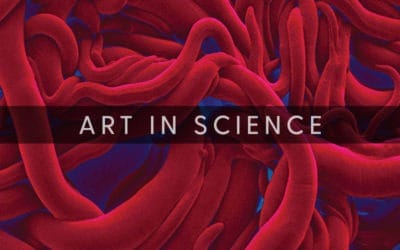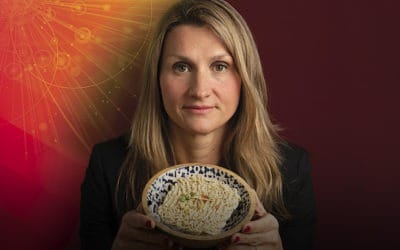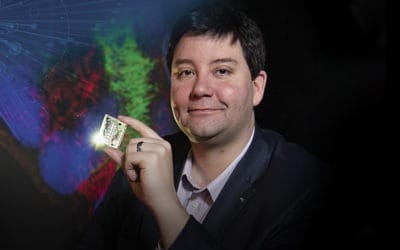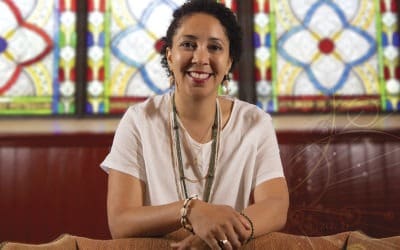
DISRUPTORS
MOVING FORWARD WITH AUTISM
One of every 40 children falls within the spectrum of disorders known as autism, according to a study published by Pediatrics in December 2018. They struggle—in varying amounts—with communication, social interaction and repetitive actions, and they experience our world in much different ways. Anjana Bhat’s work at the University of Delaware points to promising new dimensions in the therapies available to those with autism, adding creative motion, music and robotics to the therapist’s toolchest. Her work is helping patients build motor and communication skills.
Anjana Bhat
Department of Physical Therapy
MEET ANJANA
With skills in physical therapy, behavioral neuroscience and biomechanics, Anjana Bhat brings expansive expertise to her work developing creative therapies for those living with autism spectrum disorders. She sees movement as a critical piece of addressing the challenges ASD brings. With colleague Michele Lobo, she co-directs the Move to Learn Innovation Lab in UD’s College of Health Sciences, exploring new ways of helping children connect with their world and those in it. Using dance, yoga, music and robotics, she and her students are expanding our knowledge of effective approaches to these disorders.
Bhat earned her master’s degree at the University of Mumbai’s LTM Medical College and her Ph.D. in biomechanics and movement science at UD. She did postdoctoral research and training at the Kennedy Krieger Institute’s Center for Autism-Related Disorders and Johns Hopkins School of Medicine. In 2014, she joined UD’s faculty as associate professor of physical therapy with joint appointments in behavioral neuroscience, biomechanics and movement science.
Question:
What do you study, and what led you into this field?
Answer:
I am a pediatric physical therapist and I am interested in developing creative therapies for children. For the last 17 years, I have worked with children with autism and have developed different creative interventions using musical rhythms, robot trainers and creative yoga. Most recently, in collaboration with Lynnette Overby, UD professor of theatre and dance, and her students, we have developed an eight-week dance/creative movement protocol that was administered to 13 children with autism. We are still analyzing the data to determine our results.
I always wanted to make a difference, help people, work in health care, and eventually, knew that I would like to work with special needs children. Very late in my career, I was introduced to children with autism and all the difficulties faced by their families. It is a pretty devastating diagnosis. The child and his/her family have to deal with a lot of challenges–difficulties with social interaction, communication, behavioral problems, difficulties with simple transitions in everyday activities, etc. Somehow these families are also the ones with a lot of resilience and positive attitude.
I was interested in working with them and developing engaging movement themes to promote social interaction and communication in this population. The most recent theme has been dance—it seemed like an engaging way to promote social skills.
Question:
Can you recount the tipping point—the idea that produced your ‘aha!’ moment?
Answer:
I was in my postdoc years at Johns Hopkins University. Most researchers would say that children with autism have motor impairments but nothing can be done about it. That was surprising to me. The whole focus in this population is always on their social communication difficulties and not their motor difficulties. My research has shown that you can use creative movement themes that promote both motor and social communication skills of children with autism.
Question:
Were there many naysayers and how did you navigate that?
Answer:
There is a dearth of research evidence for motor interventions in children with autism. I have not had a problem convincing parents that there is value in using creative movement activities to promote skills in children with autism. Doubts are usually cast by skeptics who don’t believe in the idea of embodied cognition. The best way to deal with that is to let the evidence speak for itself. Across many different studies we find that social skills like smiling and verbalization are substantially higher when children with autism engage in socially embedded movements versus sedentary games. So there is immense value in using themes like music and movement, yoga and dance to promote social communication, cognition and motor skills in children with autism.
Question:
Did anyone in particular inspire you to think differently?
Answer:
My mother was a teacher. I think her passion for children and their learning was most inspiring to me.
Question:
What has been most satisfying about your work? Most terrifying?
Answer:
Seeing improvements in children with autism, as they smile more, talk more and move in different ways after a round of therapy. That has been very satisfying. Our relationships with families and their support has been very satisfying.
The terrifying part is when I will no longer be able to do this work. I love the work I do.
Question:
What is your favorite problem at the moment?
Answer:
Currently, my students and I are looking at brain activation patterns during naturalistic play activities to see what sorts of games facilitate brain activation in the social brain of children with autism. We are exploring the value of cooperative building games. Eventually, we would like to use cooperative play activities to facilitate social skills in those with autism.
Question:
Why do you want to keep doing this work?
Answer:
The fact that Autism Spectrum Disorder is a very complex and challenging disorder to deal with.
The hope that we can make therapy fun and a true learning experience for children.
There cannot be a be-all, end-all treatment that works for everyone. My interest is in highlighting the features and attributes of various treatment approaches and how they may work for some children and not others..
MORE STORIES
From the Vice President for Research, Scholarship and Innovation
A disruptor prevents things from proceeding as usual. But that’s not always bad. In research and education, we’re always turning ideas and methods on their ear in the quest to learn something new…
Innovation In Motion
UD researchers partner with Reebok to build a “smart” sports bra — a sports bra engineered to actually do its job!
Disruptors
This issue of the University of Delaware Research magazine puts new faces on this idea of disruption, highlighting the innovative way our researchers are tackling complex problems. Learn about their work and what drives them and how the disruption they cause can produce real benefit for our world.
Bright Star
UD’s Science, Technology and Advanced Research (STAR) Campus is shining ever brighter with the nationally recognized Tower at STAR.
Test Your Knowledge: Innovation
As a growing research institution, the University of Delaware is a place where you’ll find new ideas constantly sparking solutions to challenges once deemed impossible.The wonder of innovation is all around us, but what do you really know about it? Try your hand at these questions.
Art In Science
Now in its fourth year, this annual exhibit offers a captivating glimpse into a vast world of discovery at the University of Delaware.
The Baltimore Collection
Something truly special emerged from a box that no one expected until Julie McGee, associate professor of Africana Studies and Art History, and her University of Delaware students got their hands on the 53 photographs inside.
Disruptors: Probing the Power of Paradox
A professor of management at UD’s Lerner College of Business and Economics, Wendy Smith focuses on how leaders and teams can effectively respond to contradictory agendas.
Disruptors: Defending Equal Access to Food
How does a new supermarket impact people who live nearby? Can healthy options be found in the little store down the street? These are questions that Allison Karpyn ponders regularly.
Disruptors: Cracking a Cell’s Secret Code
Jason Gleghorn has held a variety of jobs since college—teacher, firefighter, medic, engineer. Today, he’s an interpreter of sorts, too, deciphering the language that cells use to communicate in hopes of advancing new treatments for congenital birth defects, pediatric diseases and more.
Disruptors: Making Our Way
Professor of Africana studies at UD and an ordained elder in the African Methodist Episcopal Church, Monica A. Coleman focuses on the role of faith in addressing critical social and philosophical issues.
Disruptors: Expanding Our World View
These co-founders of the Robotic Discovery Laboratories in UD’s College of Earth, Ocean and Environment manage a growing robotics fleet for use on land, in air and under the sea. They explore questions along the coast, at the poles and in deep regions of the ocean.
Disruptors: Harnessing Beneficial Microbes
So, what do a virologist, botanist and soil physicist have in common? This team from UD’s College of Agriculture and Natural Resources is leveraging their collective expertise to ensure that our food supply is safe and abundant, now and in the future.
Honors
UD researchers have been recognized recently by the National Institutes of Health, American Political Science Association, TED Fellows program, National Science Foundation, National Academy of Inventors and the Gates Cambridge Scholarship program.
News Briefs
Check out some recent developments, from the launching of major research programs to address environmental and health issues in the First State, to the preservation of a pair of 1909 mittens with a hallowed history.
CONTACT
Tracey Bryant
Senior Director, Research Communications
Email: tbryant@UDel.Edu
SUBSCRIBE & CONNECT
The University of Delaware Research magazine showcases the discoveries, inventions and excellence of UD’s faculty, staff and students. Sign up for a free subscription.



